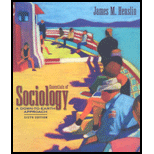Sorry! We don’t have solutions for this edition yet.
Solutions are available for other editions of this book
View 12th Edition solutionsarrow_forwardBook Details
I. THE SOCIOLOGICAL PERSPECTIVE.
1. The Sociological Perspective.
The Sociological Perspective.
The Origins of Sociology.
Sexism in Early Sociology.
Sociology in North America.
Theoretical Perspectives in Sociology.
Doing Sociological Research.
Research Methods.
Ethics in Sociological Research.
2. Culture.
What Is Culture?
Components of Symbolic Culture.
Many Cultural Worlds Subcultures and Countercultures.
Values in U.S. Society.
Technology in the Global Village.
3. Socialization.
What Is Human Nature?
Socialization into the Self, Mind, and Emotions.
Socialization into Gender.
Agents of Socialization.
Resocialization.
Socialization Through the Life Course.
Are We Prisoners of Socialization?
4. Social Structure and Social Interaction.
Levels of Sociological Analysis.
The Macrosociological Perspective Social Structure.
The Microsociological Perspective Social Interaction in Everyday Life.
The Need for Both Macrosociology and Microsociology.
II. SOCIAL GROUPS AND SOCIAL CONTROL.
5. Social Groups and Formal Organizations.
Social Groups.
Bureaucracies.
Working for the Corporation.
Group Dynamics.
6. Deviance and Social Control.
What Is Deviance?
The Symbolic Interactionist Perspective.
Differential Association Theory.
The Functionalist Perspective.
The Conflict Perspective.
Reactions to Deviance.
III. SOCIAL INEQUALITY.
7. Global Stratification
An Overview of Social Stratification.
What Determines Social Class?
Why Is Social Stratification Universal?
Maintaining Global Stratification.
How Do Elites Maintain Stratification?
Comparative Social Stratification.
Global Stratification Three Worlds.
How Did the World's Nations Became Stratified?
8. Social Class in the United States.
What Is Social Class?
Sociological Models of Social Class.
Consequences of Social Class.
Social Mobility.
Poverty.
9. Inequalities of Race and Ethnicity.
Laying the Sociological Foundation.
Theories of Prejudice.
Global Patterns of Intergroup Relations.
Race and Ethnic Relations in the United States.
Looking Toward the Future.
10. Inequalities of Gender and Age.
Inequalities of Gender.
Issues of Sex and Gender.
How Females Became a Minority Group.
Gender Inequality in the United States.
The Changing Face of Politics.
Inequalities of Aging.
Aging in Global Perspective.
The Symbolic Interactionist Perspective.
The Functionalist Perspective.
The Conflict Perspective.
Looking Toward the Future.
IV. SOCIAL INSTITUTIONS.
11. Politics and the Economy.
Politics Establishing Leadership.
Power, Authority, and Violence.
Types of Government.
The U.S. Political System.
Who Rules the United States?
War and Terrorism A Means to Implement Political Objectives.
The Economy Work in the Global Village.
The Transformation of Economic Systems.
Capitalism in a Global Economy.
12. Marriage and Family.
Marriage and Family in Global Perspective.
Marriage and Family in Theoretical Perspective.
The Family Life Cycle.
Diversity in U.S. Families.
Trends in U.S. Families.
Divorce and Remarriage.
Two Sides of Family Life.
The Future of Marriage and Family.
13. Education and Religion.
Education Transferring Knowledge and skills.
Education in Global Perspective.
The Functionalist Perspective Providing Social Benefits.
The Conflict Perspective Perpetuating Social Inequality.
The Symbolic Interactionist Perspective Fulfilling Teacher Expectations.
Problems in U.S. Education-And Their Solutions.
Religion Establishing Meaning
What Is Religion?
The Functionalist Perspective.
The Symbolic Interactionist Perspective.
The Conflict Perspective.
Religion and the Spirit of Capitalism.
Types of Religious Groups.
Religion in the United States.
The Future of Religion.
V. SOCIAL CHANGE.
14. Population and Urbanization.
Population in Global Perspective.
A Planet with No Space to Enjoy Life?
Population Growth.
City Life.
Urbanization.
The Development of Cities.
Urban Problems and Social Policy.
15. Social Change Technology, Social Movements, and the Environment.
How Social Change Transforms Social Life.
Theories and Processes of Social Change.
How Technology Changes Society.
The Growth Machine Versus the Earth.
Social Movements as a Source of Social Change.
ONLINE CHAPTER The Sociology of Human Sexuality.
What Does Sociology Have to Do with Sex?
The Social Construction of Sexual Identity.
The Incest Taboo Social Control of Human Sexuality.
Homosexuality Gay and Lesbian Sexual Behavior.
Heterosexuality.
A Concluding Note.
ONLINE CHAPTER Health and Medicine.
Sociology and the Study of Medicine.
The Symbolic Interactionist Perspective.
The Functionalist Perspective.
The Conflict Perspective.
Historical Patterns of Health.
Issues in Health Care.
Threats to Health.
The Search for Alternatives.
More Editions of This Book
Corresponding editions of this textbook are also available below:
